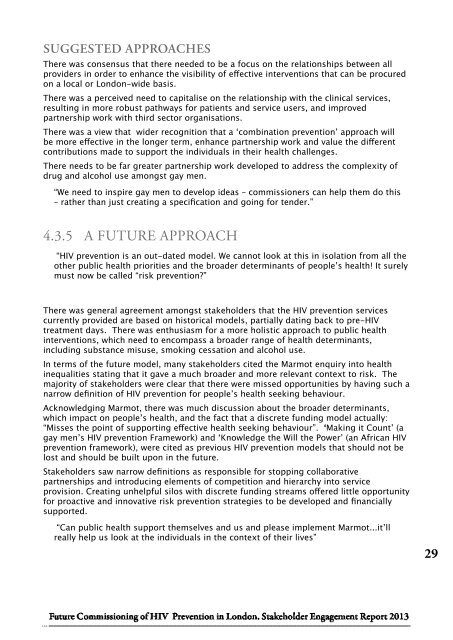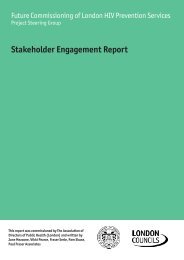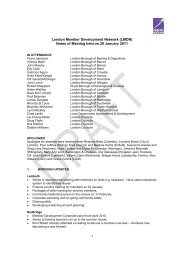Stakeholder Engagement Report - London Councils
Stakeholder Engagement Report - London Councils
Stakeholder Engagement Report - London Councils
Create successful ePaper yourself
Turn your PDF publications into a flip-book with our unique Google optimized e-Paper software.
Suggested Approaches<br />
There was consensus that there needed to be a focus on the relationships between all<br />
providers in order to enhance the visibility of effective interventions that can be procured<br />
on a local or <strong>London</strong>-wide basis.<br />
There was a perceived need to capitalise on the relationship with the clinical services,<br />
resulting in more robust pathways for patients and service users, and improved<br />
partnership work with third sector organisations.<br />
There was a view that wider recognition that a ‘combination prevention’ approach will<br />
be more effective in the longer term, enhance partnership work and value the different<br />
contributions made to support the individuals in their health challenges.<br />
There needs to be far greater partnership work developed to address the complexity of<br />
drug and alcohol use amongst gay men.<br />
“We need to inspire gay men to develop ideas – commissioners can help them do this<br />
– rather than just creating a specification and going for tender.”<br />
4.3.5 A future approach<br />
“HIV prevention is an out-dated model. We cannot look at this in isolation from all the<br />
other public health priorities and the broader determinants of people’s health! It surely<br />
must now be called “risk prevention?”<br />
There was general agreement amongst stakeholders that the HIV prevention services<br />
currently provided are based on historical models, partially dating back to pre-HIV<br />
treatment days. There was enthusiasm for a more holistic approach to public health<br />
interventions, which need to encompass a broader range of health determinants,<br />
including substance misuse, smoking cessation and alcohol use.<br />
In terms of the future model, many stakeholders cited the Marmot enquiry into health<br />
inequalities stating that it gave a much broader and more relevant context to risk. The<br />
majority of stakeholders were clear that there were missed opportunities by having such a<br />
narrow definition of HIV prevention for people’s health seeking behaviour.<br />
Acknowledging Marmot, there was much discussion about the broader determinants,<br />
which impact on people’s health, and the fact that a discrete funding model actually:<br />
“Misses the point of supporting effective health seeking behaviour”. ‘Making it Count’ (a<br />
gay men’s HIV prevention Framework) and ‘Knowledge the Will the Power’ (an African HIV<br />
prevention framework), were cited as previous HIV prevention models that should not be<br />
lost and should be built upon in the future.<br />
<strong>Stakeholder</strong>s saw narrow definitions as responsible for stopping collaborative<br />
partnerships and introducing elements of competition and hierarchy into service<br />
provision. Creating unhelpful silos with discrete funding streams offered little opportunity<br />
for proactive and innovative risk prevention strategies to be developed and financially<br />
supported.<br />
“Can public health support themselves and us and please implement Marmot...it’ll<br />
really help us look at the individuals in the context of their lives”<br />
29




